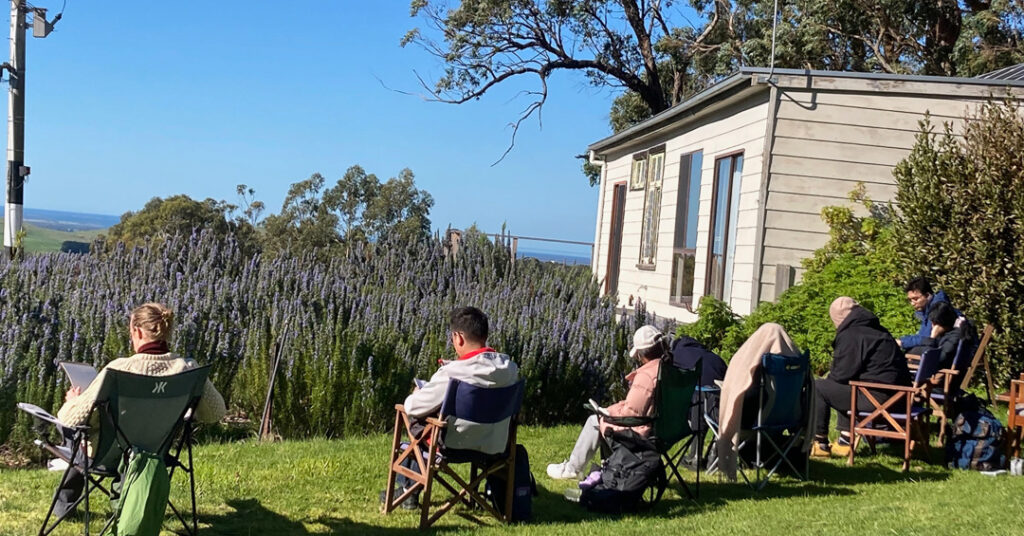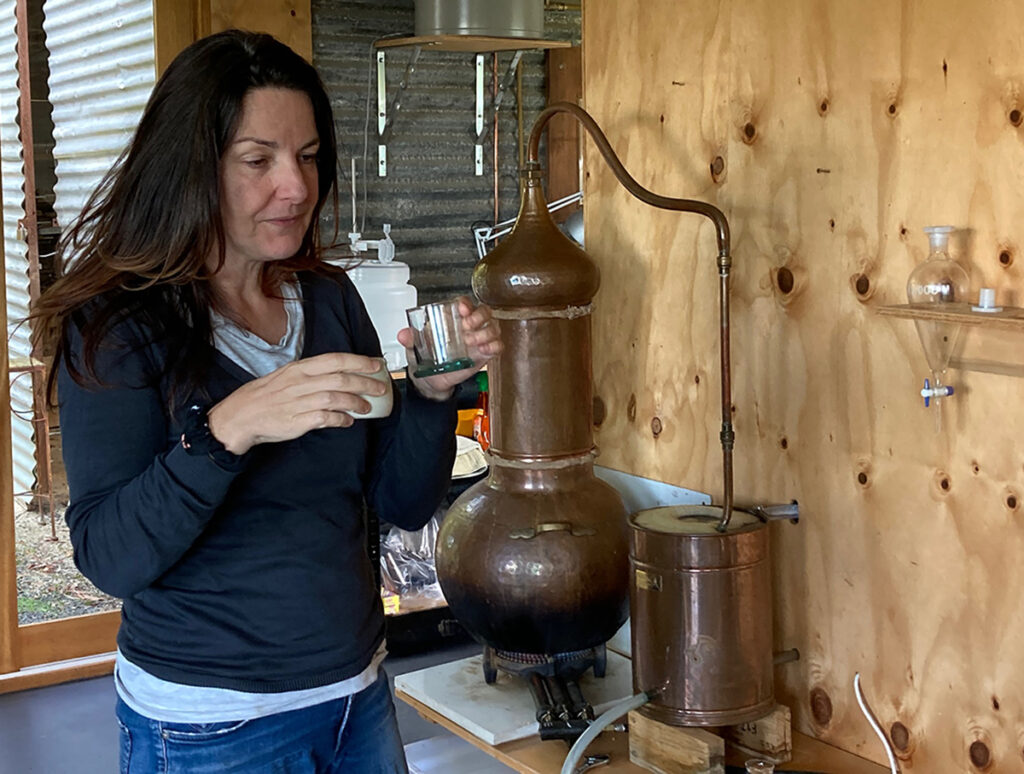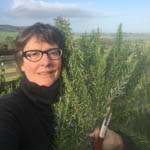
Masters of Architecture students from the University of Melbourne on their Sensory (Re)treat, August 2023; photo: Bridget Nicholson
For Bridget Nicholson, rosemary distillation is a fragrant craft that grounds the senses.
The essence of life has appeared to me gradually. A seeping, drifting amorphous enveloping that slowly but surely has revealed itself through the sensorial.
There was constant moving throughout my childhood. Every couple of years a new country, new house, new place, new people. What I now realise is that in order to cope, to take in the new, and find a place within it, I sunk into my senses the smells, the sounds and the textures of these defined places. This reliance on the sensorial is embedded in me and has directed my pathway through life. It has led me through architecture to the arts, where craft making has provided the means to explore connection to place and culture, revealing a depth and breadth of knowledge that has made me feel part of the world, and given me a sense of belonging.
My mother named India as her favourite place to live because of the variety and richness of its crafts. We lived there when I was 3-6 years of age. Fifty years later I had a stall at a farmers’ market in Melbourne, selling rosemary oil and rosemary water, the products of distilling the rosemary I grow in South Gippsland. An Indian woman walked past in her traditional sari. I smelt her: the tangy earthly mix of cumin, turmeric and sandalwood. I had an overwhelming desire to bury my head in her lap, her shoulder, and breathe her in. I could feel the paper-like quality of her skin, the soft folds of her sari. I rushed over to get close, to absorb her, to be back in that place within myself.
The three tones come together balancing and singing with each other to create the whole
My introduction to essential oils was through a two-day workshop in Melbourne in 1989. One of the exercises in the workshop was to make a blend of three oils in a carrier oil and rub this all over your body. The mix had to incorporate one oil each identified as base, middle and top “note.” The notes are a means by which aromas are categorised in the field of perfumery. The top note comes first but does not last. It includes citrus and lemongrass. The middle note forms the core. It is the heart of the aroma as a whole: lavender and eucalyptus. Meanwhile, the base note provides the earthy, vibrational tone: sandalwood and vetiver. These categories make sense when you think of smells as music. The three tones come together balancing and singing with each other to create the whole.
The three-oil blend became a ritual. I would make a mix every morning and cover myself head to toe. This wrapping of myself in aromas was hugely beneficial as at the time I was studying architecture, struggling with, and feeling suffocated by, the need to be rational and able to explain design decisions, in what seemed at the time a very mundane manner. Somehow not expressive of the whole. Through the wrapping of myself in delicious aroma I felt shrouded. I found I could affect my emotional state, protect my heart and nurture myself.
Today I grow and distill rosemary salvia officinalis in South Gippsland Australia. This is part of my work, the other part is making things. The things I made used to be artworks (craftworks) that were in effect research, the mechanism through which I could explore environments and people seeking out connections as I tried to find my own. Most recently I have reverted to the making of useful things: still craft processes, but functional ware rather than philosophical meanderings. The writing of this piece has enabled me to see where the distilling fits in, and why it is here in my life. It has brought me full circle, made me complete and relieved me of the need to keep searching, simultaneously honouring smell and acknowledging its’ place in my past and emotional well-being.
I had also always wanted to be a farmer
The dictionary definition of distillation is a process of vapourisation followed by condensation to concentrate and purify, the extraction of volatile components. I stumbled into distillation. A friend had a still that she was wanting to pass on. Alongside my appreciation for essential oils, I had also always wanted to be a farmer but was fearful, feeling farming is something you need to be born into, to learn from your elders, not through a book. But I do love growing things and have always made vegetable gardens wherever I have been. This notion of growing something and distilling it to produce smelly treasures of life seemed possible, like a good way for me to bring together things I love. Accepting the offer of the still set in motion a string of changes in how I was living. A move from the city to the country, and a shift in making from artworks, to more practical, day-to-day things.
Distillation is an ancient craft. Stills used by artisan distillers today are not dissimilar to those used in Ancient Greece over 2000 years ago. Commercial methods have been adopted, however, those employing the vaporisation and condensation technique differ only in the design and materials of the equipment. Traditional stills are copper, water is boiled in the pot producing steam which passes through plant material compacted in the column and top. The steam carrying the oils and aromatics is then passed through a cold bath to condense back into a liquid form containing pure, intense aromatics. The oil floats to the top enabling the aromatic water to be drained off, producing two products; essential oil and hydrosol (aromatic water).
A typical distilling day starts with an appraisal of the weather! Warm weather brings the oil content up in plants. This can be further enhanced if the plant is slightly stressed, and not recently watered. I prefer to think of this as the plant being in its most energetic state. No rain for a few days, lovely warm weather, and I will harvest at 11 am. The rosemary is then stripped from its stem. I do this sitting outside preferably with another to chat to. The stripping takes over an hour with two people. The leaves are then packed into the still, both the column and the top and weighed. I am doing four to five kilos at a time. The weight determines the amount of water to go into the pot. In a steam distillation, I double the weight of plant so 4kg rosemary will require 8 litres of water. The still is then put together and the fire started to boil the water.
At this stage, the still needs to be sealed at the joints for which I make up a paste of rye flour and water, roll this into sausages and press on the joints where it bakes and seals. Then it is time to watch closely for the first drop of liquid to come through. This is heralded by a wash of rosemary fumes appearing a few minutes before the liquid. I then adjust the temperature to create a slow steady flow. One distillation will take 11/2 to 2 hrs from the appearance of the first drop. I drain the hydrosol (aromatic water) off every 6-8 minutes and taste and record the pH. I find the taste indicative of what is happening in the still. The taste of the hydrosol varies from start to finish, this being called the head, middle and tail. I collect the three together to make one well-rounded taste sensation. In every aspect of the process, there is room to fiddle and vary your results, heat faster, cool quickly, use fresh or dried plant matter, seasonal variation and so on. At the end of the process, the distillery/studio smells superb, which lasts for numerous days.

Corinne from Madam Flavour tasting hydrosol during the distillation workshop; photo: Bridget Nicholson
They say that fires warm you five times; through cutting, splitting, stacking, moving restacking and finally burning. Distilling is similar: weeding, mulching, watering, harvesting, stripping and finally distilling. Each activity means time spent immersed in aromas that never fail to restore, soothe and bring joy.
Like wine, plant aromatics are a product of their place. Their terroir will affect their chemical composition and hence their smell. In South Gippsland, the weather is cool and wet. However, the most affective aspect is the soil. The property is in a region known as Granite Bar because that is what it is grey sandy soil with course white crystals through it, devoid of humus, the product of weathered granite. In these conditions, the rosemary we grow and distil produces what is called chemotype Verbenone. One of three chemotypes (ct Camphor, ct 1.8 Cineole and ct Verbenone) associated with rosemary each of which has a different aroma and chemical composition. This in turn affects its therapeutic qualities.
The oil is pungent. It swells in your nostrils demanding to be taken down into the depths of your lungs. It is almost acrid with a slight sweetness, stimulating and active rather than a passive smell, but also calming and grounding.
I now live surrounded by rosemary which currently is in full flower, buzzing with life as the bees from kilometres around descend to feast on the nectar. I have found that the process of growing and distilling has literally planted me in life. The physical work, and the slowness of growing and tending plants, have given me the time and space to see the progression and trace of my life. The importance of the making and the history and stories embedded in craft practices. Time spent with others both animate and inanimate has been a drawing in and collection of knowledge through all the senses. The growing and distilling of rosemary has completed the circle, given me a sense of belonging and grounded me in one place.
Resources
Phillippe Mailhebiau, Portraits of Oils – The personality of aromatherapy oils and their links with human temperaments, 1995
Ann Harman, Harvest to hydrosol, 2015
Frauke Galia, An aromatic life, podcast
About Bridget Nicholson
 I love making things and am deeply interested in materials that come from the natural world. My current project is a book that probes belonging using my art practice as the research medium. I am also enjoying having people come to the farm to do distilling workshops. I hope down the track to be able to provide accommodation and enable artists to come and work here. Visit and purchase www.granitebarrosemary.com.au.
I love making things and am deeply interested in materials that come from the natural world. My current project is a book that probes belonging using my art practice as the research medium. I am also enjoying having people come to the farm to do distilling workshops. I hope down the track to be able to provide accommodation and enable artists to come and work here. Visit and purchase www.granitebarrosemary.com.au.





Comments
A beautiful recounting of how an artist found their unusual medium. Thank you for sharing.